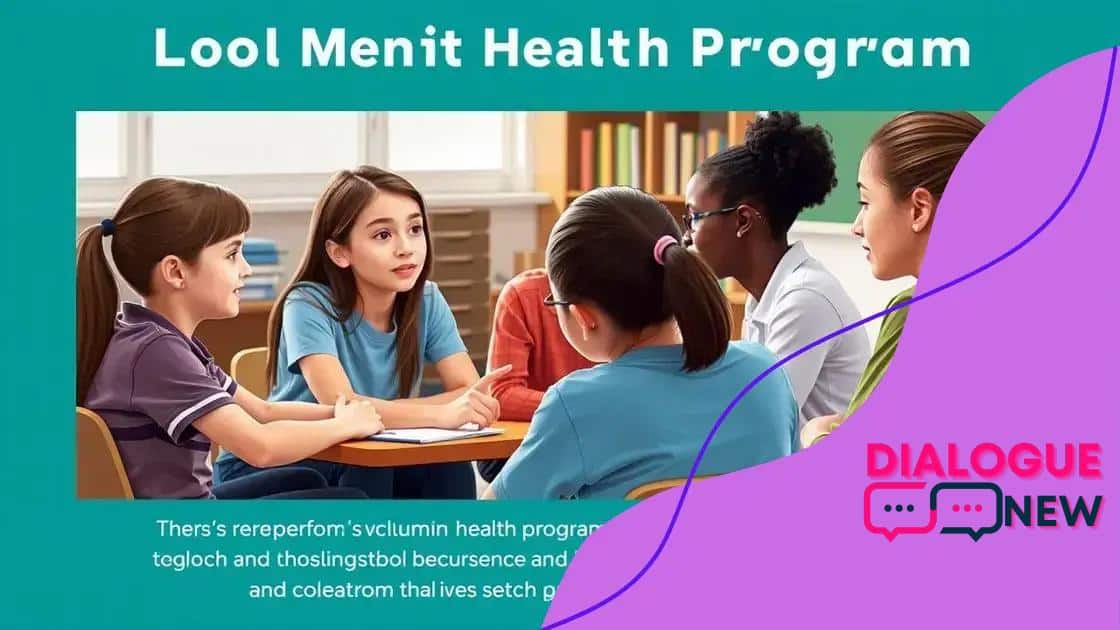The importance of mental health resources in schools

The importance of mental health resources in schools is crucial for enhancing academic success, emotional well-being, and creating a supportive environment for students, ultimately paving the way for healthier future generations.
The importance of mental health resources in schools cannot be overstated. Students face significant pressures, and having proper support can make a world of difference. Have you ever wondered how mental health resources impact student life?
Understanding mental health in the school context
Understanding mental health in the school context is essential for creating a supportive environment for students. Mental health affects how students think, feel, and act, and it plays a major role in their academic success and overall well-being.
Key Aspects of Mental Health
Schools must recognize the importance of fostering a healthy atmosphere. This can involve a variety of measures that promote positive mental health among students.
- Creating awareness around mental health issues.
- Encouraging open conversations about emotions.
- Providing access to professional support.
- Implementing programs that teach coping skills.
In addition, understanding mental health means being aware of the signs that a student may be struggling. Some common indicators include changes in behavior, declining academic performance, and withdrawal from social interactions. By identifying these signs early, schools can intervene and provide necessary support.
Promoting a Positive Environment
Creating a nurturing environment is crucial. Teachers and staff should be trained to recognize mental health challenges and to offer support appropriately. This can involve having regular check-ins with students and fostering relationships built on trust.
Additionally, schools can implement activities that promote well-being, such as mindfulness sessions, stress management workshops, and peer support groups. These initiatives help students feel valued and supported, which in turn enhances learning experiences.
Overall, understanding mental health in schools is about more than just addressing problems. It’s about fostering a positive environment that encourages students to thrive both academically and emotionally. By focusing on mental well-being, schools can help pave the way for a brighter future for all students.
Benefits of mental health resources for students
The benefits of mental health resources for students are significant and far-reaching. When schools provide access to mental health support, students are more likely to feel safe, understood, and capable of achieving their academic goals.
Improved Academic Performance
One major benefit includes an improvement in academic performance. Students who receive mental health support often show better focus and higher grades. They are better equipped to handle stress and manage their time effectively.
- Less absenteeism due to mental health issues.
- Higher engagement in classroom activities.
- Better relationships with teachers and peers.
- Early intervention can prevent future problems.
Additionally, having access to mental health services helps students develop essential life skills. These services teach coping mechanisms and resilience, which are critical for navigating both school and life challenges.
Enhanced Emotional Well-Being
Another important benefit is the enhancement of students’ emotional well-being. Mental health resources provide spaces for students to express their feelings and concerns openly. This reduces feelings of isolation and promotes a sense of belonging.
Programs focused on mental health often include mindfulness practices and emotional regulation techniques. Such practices can lead to decreased anxiety and depression among students, helping them manage their emotions more effectively.
In summary, investing in mental health resources at schools is crucial. It enables students to thrive not just academically but also emotionally, paving the way for their future success.
Effective mental health programs in schools

Effective mental health programs in schools are designed to address the unique needs of students. These programs aim to promote well-being, enhance coping skills, and create a supportive environment.
Key Features of Successful Programs
Successful mental health programs often include several key features. They provide accessibility, integrate various services, and focus on prevention. By making resources readily available, schools help students access support without barriers.
- Onsite counseling services to handle immediate concerns.
- Workshops focused on stress management and coping strategies.
- Training for teachers on recognizing mental health issues.
- Peer support initiatives to foster a sense of community.
Additionally, these programs need to involve parents and the community. Engaging families in the process creates a more comprehensive support system. Information sessions can help parents understand the resources available and how to encourage their children to utilize them.
Building Resilience in Students
Another vital aspect is building resilience among students. This involves teaching skills to help them cope with stress and overcome challenges. Programs that incorporate social-emotional learning (SEL) facilitate this development.
SEL programs can include activities like conflict resolution, emotional regulation, and teamwork exercises. By teaching these skills, schools help students face difficulties with confidence and improve their overall mental health.
Ultimately, effective mental health programs make a significant impact on students’ lives. By prioritizing mental health, schools contribute not only to academic success but also to lifelong well-being.
Overcoming challenges in providing mental health support
Overcoming challenges in providing mental health support in schools is crucial for the success of any program. Despite the growing recognition of the importance of mental health resources, schools often face obstacles in their implementation.
Common Barriers
One of the main challenges is funding. Many schools struggle to allocate enough budget for mental health programs. This limited funding can restrict the number of professionals available to help students and limit the resources that are offered.
- Insufficient numbers of trained counselors.
- Lack of awareness about available resources.
- Stigma surrounding mental health issues.
- Resistance from school administration and staff.
Another significant barrier is the stigma associated with mental health. Many students may hesitate to seek help due to fear of being judged or labeled. This is why creating a safe and supportive environment is essential for encouraging students to utilize mental health services.
Strategies for Improvement
To overcome these challenges, schools can adopt several effective strategies. First, they can actively seek partnerships with local mental health organizations. These partnerships can provide additional resources and training for staff, improving overall support.
Additionally, increasing awareness within the school community can help break down barriers. Educational campaigns that promote the importance of mental health can create a culture of openness and acceptance. By engaging students, parents, and staff, schools can foster a supportive environment that encourages seeking help.
Ultimately, addressing these challenges is vital for ensuring all students have access to the mental health support they need to succeed academically and emotionally.
Future trends in school mental health resources
Future trends in school mental health resources are evolving rapidly to meet the needs of students more effectively. Schools are beginning to recognize the necessity of mental health support as a critical aspect of education.
Integration of Technology
One significant trend is the integration of technology in mental health resources. Online counseling and mental health apps are becoming more common, allowing students to access support anytime and anywhere. This can increase engagement, especially among those who may feel uncomfortable seeking help in person.
- Teletherapy options for remote students.
- Digital platforms for group therapy and community building.
- Apps that offer mindfulness exercises and mood tracking.
- Interactive resources for parents and teachers to support students.
Moreover, the use of artificial intelligence (AI) can enhance the personalization of mental health care in schools. AI-driven programs can help in identifying students who may need additional support based on their behavior and academic performance.
Focus on Proactive Approaches
Another emerging trend is the shift toward proactive mental health strategies. Schools are increasingly emphasizing well-being initiatives that focus on prevention rather than just response. This can include resilience training and social-emotional learning (SEL) programs that teach students essential life skills.
Programs that educate students about mental health and encourage open discussions contribute to destigmatizing these issues. As awareness grows, more schools are likely to adopt comprehensive mental health plans that prioritize student well-being from an early age.
Overall, the future of mental health resources in schools looks promising, with a focus not only on immediate support but also on fostering resilience and overall mental wellness.
FAQ – Frequently Asked Questions about Mental Health Resources in Schools
Why are mental health resources important in schools?
Mental health resources are vital as they help students cope with stress, improve academic performance, and enhance emotional well-being.
What are some effective mental health programs?
Effective programs include counseling services, resilience training, and social-emotional learning (SEL) initiatives that promote skills for coping with challenges.
How can schools overcome challenges in providing mental health support?
Schools can overcome challenges by increasing awareness, engaging the community, and integrating technology to enhance accessibility.
What future trends should we expect in school mental health resources?
Future trends include more technology integration, a focus on proactive strategies, and stronger partnerships with mental health organizations.





